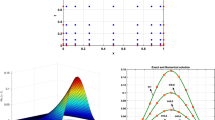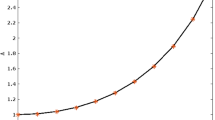Abstract
In this paper, by using the theory of Butcher series, a general expression of the order conditions on the coefficients of a multi-revolution Runge–Kutta method is derived. A complete study of explicit multi-revolution Runge–Kutta methods of order four with four stages is given. Also, by using suitable simplifying assumptions, a family of six stage explicit methods with order five is derived and a particular method of this family (which generalizes the well known formula of order five in DOPRI5(4)) is selected by minimizing a norm of the leading term of the local truncation error. Finally, some numerical experiments are presented to test the behaviour of the new fifth-order method.
Similar content being viewed by others
References
J.C. Butcher, The Numerical Analysis of Ordinary Differential Equations (Wiley, New York, 1987).
M. Calvo, L.O. Jay, J.I. Montijano and L. Rández, Approximate compositions of a near identity map by multi-revolution Runge–Kutta methods, Numer. Math. 97 (2004) 635–666.
J. Dormand and P. Prince, A family of embedded Runge–Kutta formulae, J. Comput. Appl. Math. 6 (1980) 19–26.
C.W. Gear, Automatic detection and treatment of oscillatory and/or stiff ordinary differential equations, in: Numerical Integration of Differential Equations and Large Linear Systems. Proceedings, Bielefeld (1980), Lecture Notes in Mathematics (Springer, New York, 1982) p. 968.
C.W. Gear and K.A. Gallivan, Automatic methods for highly oscillatory ordinary differential equations, in: Numerical Analysis Proceedings Dundee 1981, Lecture Notes in Mathematics (Springer, New York, 1982) p. 912.
O.F. Graf, Multirevolution Methods for Orbit Integration, Lecture Notes in Mathematics, Vol. 362 (Springer, Berlin, 1973) pp. 471–490.
O.F. Graf and D.G. Bettis, Modified multirevolution integration methods for satellite orbit computation, Celestial Mechanics 11 (1975) 443–448.
E. Hairer, S.P. Nørsett and G. Wanner, Solving Ordinary Differential Equations I, Nonstiff Problems, 2nd revised edn. (Springer, Berlin, 1993).
U. Kirchgraber, An ODE solver based in the method of averaging, Numer. Math. 53 (1988) 621–652.
D. Mace and L.H. Thomas, An extrapolation method for stepping the calculations of the orbit of an artificial satellite several revolutions ahead at a time, Astronom. J. 65 (1960) 1280.
B. Melendo, Long term numerical integration of quasi periodic problems, Ph.D. thesis, University of Zaragoza (2000).
B. Melendo and M. Palacios, A new approach to the construction of multirevolution methods and their implementation, Appl. Numer. Math. 23 (1997) 259–274.
W.L. Miranker and G. Wahba, An averaging method for the stiff highly oscillatory problem, Math. Comput. 30 (1976) 383–399.
L.R. Petzold, An efficient numerical method for highly oscillatory ordinary differential equations, SIAM J. Numer. Anal. 18 (1981) 455–479.
L.R. Petzold, L.O. Jay and J. Yen, Numerical solution of highly oscillatory ordinary differential equations, Acta Numerica (1997) 437–483.
G.P. Taratynova, Numerical solution of equations of finite differences and their application to the calculation of orbits of artificial earth satellites, ARS Journal Supplement to Artificial Earth Satellites 4 (1960) 56–85.
Author information
Authors and Affiliations
Corresponding author
Additional information
Communicated by Jesus Carnicer and Juan Manuel Peña
This paper is dedicated to Professor M. Gasca on the occasion of his 60th birthday
Mathematics subject classifications (2000)
65L05, 65M20.
This work was supported by project BFM2001-2562.
Rights and permissions
About this article
Cite this article
Calvo, M., Montijano, J.I. & Rández, L. On explicit multi-revolution Runge–Kutta schemes. Adv Comput Math 26, 105–120 (2007). https://doi.org/10.1007/s10444-004-7209-z
Received:
Accepted:
Published:
Issue Date:
DOI: https://doi.org/10.1007/s10444-004-7209-z




